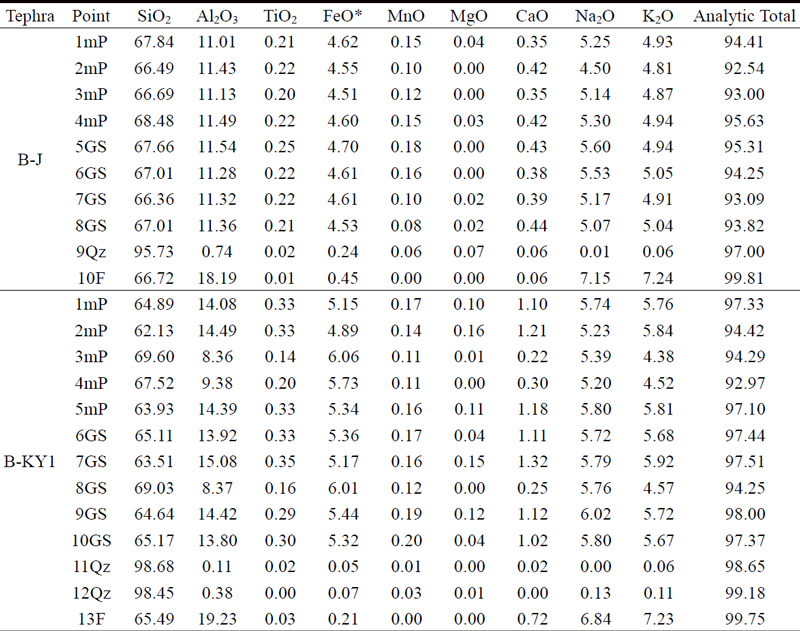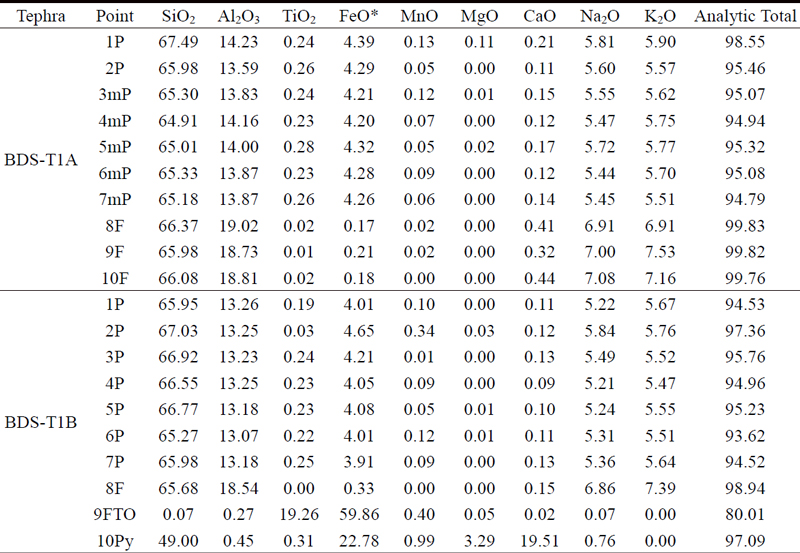
동해 해저코어에서 발견된 중기 플라이스토세 B-KY1 테프라와 백두산 화산에서 채취된 BDS-T1 테프라의 비교 분석
초록
백두산 화산의 중기 플라이스토세 플리니식 분화(약 135,000년 전)로 동쪽으로 약 900 km 떨어진 동해 ODP 794A 해저코어에 Baekdusan-KitaYamato1 (B-KY1) 테프라가 이동 퇴적되었다. 기존 연구에서 백두산 화산의 ‘천년분화(940∼950 CE)’ 테프라에 포함된 일부 저어콘의 연대가 110,000~130,000년 전으로 분석되었는데, 이것은 그 당시에 백두산 화산에서 마그마 형성과 화산 분화의 가능성을 지시하는 것이다. 백두산 화산에서는 Biotoushan III 조면암/코멘다이트 용암류(20,000~220,000년 전)의 직하부에서 적갈색의 Baekdusan-T1(BDS-T1) 테프라가 발견되었다. 이 연구에서는 백두산 화산에서 채취된 BDS-T1 테프라와 해저코어에서 발견된 B-KY1 테프라의 층서적 위치와 주원소 조성을 비교 분석하였다.
Abstract
During the Middle Pleistocene Plinian eruption of Baekdusan volcano, approximatly 135,000 years ago, Baekdusan-KitaYamato1 (B-KY1) tephra was transported and deposited in ODP 794A marine core in the East Sea, located approximately 900 km to the east of Baekdusan volcano. In previous studies, the age of some zircon included in the ‘millennial eruption (940-950 CE)’ tephra from Baekdusan volcano was analyzed to be 110,000 to 130,000 years ago. This suggests the possibility of magma formation and volcanic eruption at Baekdusan volcano during that period. Reddish-brown Baekdusan-T1 (BDS-T1) tephra was discovered beneath the Biotoushan III trachyte/comendite lava unit in Baekdusan volcano, dating from 20,000 to 220,000 years ago. This study conducted a comparative analysis of the stratigraphic positions and major elemental composition between BDS-T1 tephra collected from Baekdusan volcano and B-KY1 tephra found in marine core.
Keywords:
Middle Pleistocene, Plinian eruption, B-KY1 tephra, BDS-T1 tephra, Baekdusan volcano키워드:
중기 플라이스토세, 플리니식 분화, B-KY1 테프라, BDS-T1 테프라, 백두산 화산1. 서 론
백두산 화산의 플리니식 분화(plinian eruption) 기록은 백두산 화산체 부근과 화산으로부터 수 백 km 이상 떨어진 동해 해저퇴적층과 일본 육상 퇴적층에 보존되어 있으며, 지금까지 알려진 플리니식 분화는 약 448,000년 전부터 최소 8 차례 발생되었다(Chun and Cheong, 2020; Chun, 2022). Baekdusan-Tomakomai (B-Tm) 테프라는 백두산 화산의 940~950 CE 플리니식 분화로 백두산으로부터 동쪽으로 약 1,100 km 떨어진 일본 홋카이도 토마코마이(Tomakomai) 퇴적층과 남동쪽으로 약 990 km 떨어진 일본 혼슈 스이게츠호수(Lake Suigetsu) 퇴적층에서도 발견되었다(그림 1; Machida and Arai, 1983; McLean et al., 2016). 동해 해저코어에서 Baekdusan-Japan Basin (B-J) 테프라는 전 지구적 고기후 변동에 의한 아간극기 14(interstadial 14)에 해당하는 층서적 위치에서 발견되었으며, 백두산 화산의 플리니식 분화에 의해서 약 51,500년 전에 이동 퇴적된 것으로 해석된다(Chun et al., 2006b). Baekdusan-Oga (B-Og) 테프라는 약 448,000년 전에 백두산 화산의 플리니식 분화로 남동쪽으로 약 1,000 km 떨어진 일본 혼슈 오가반도(Oga peninsula)에서 보고된 것이다(그림 1; Shirai et al., 1997). 그리고 백두산 화산으로부터 남동쪽으로 약 550 km 떨어진 동해 키타야마토해곡(KitaYamato Trough)에서 채취된 20EEZ-1 해저코어에서는 중기 플라이스토세 시기의 플리니식 분화로 원거리 이동되어 쌓인 Baekdusan-KitaYamato1 (B-KY1) 테프라(약 130,000년 전)와 Baekdusan-KitaYamato2 (B-KY2) 테프라(196,000년 전)가 처음으로 보고되었다(Chun et al., 2006a). 최근에 백두산 화산으로부터 동쪽으로 약 900 km 떨어진 곳에서 채취된 ODP 794A 해저코어에서 발견된 B-KY1 테프라의 연구에서는 이 테프라의 분화 시기가 두번째 해빙기(penultimate deglaciation) 시작하는 시점인 약 135,000년 전으로 재해석되었고, 테프라 입자들이 코멘다이트질 조면암(commenditic trachyte)과 유문암(rhyolite)인 코멘다이트(commendite) 뿐만 아니라 일부는 고알칼리질(peralkaline) 유문암인 펜텔러라이트(pantellerites)가 포함되어 있는 것으로 분석되었다(Chun and Cheong, 2020). 백두산 화산으로부터 원거리 이동되어 쌓인 테프라 중에서 B-KY1 테프라에서 처음으로 고알칼리질 펜텔러라이트가 보고되었다(Chun and Cheong, 2020).
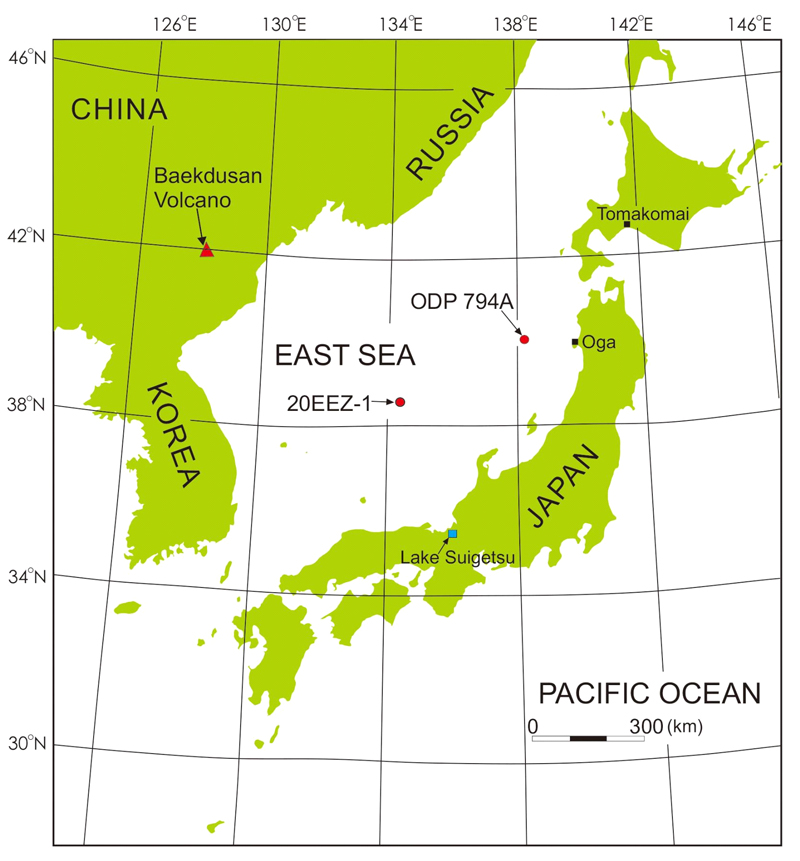
Map showing the locations of Baekdusan volcano, marine cores, and tephra type location in the East Sea region. Solid red circles: marine cores in the East Sea, Solid black squares: type locations of Baekdusan-Tomakomai (B-Tm; Machida and Arai, 1983) and Baekdusan-Oga (B-Og; Shirai et al., 1997) tephras on the Japanese volcanic islands.
백두산 화산체 부근에서는 B-Tm 테프라의 분화 시기에 쌓인 조면암 또는 유문암 성분의 화쇄류암(ignimbrites)이 보고되었다(Horn and Schmincke, 2000; Wei et al., 2003, 2007). 이 화쇄류암은 ‘천년분화(Millennium eruption)’ 퇴적층으로 알려져있다(Wei et al., 2013). 백두산 화산의 ‘천년분화’ 퇴적층에서 분리된 저어콘의 U-Th 비평형 연대는 11,000년~12,000년 전, 110,000년~130,000년 전, 230,000년 전으로 분석되었으며, 저어콘은 다양한 시기에 서로 다른 마그마로부터 형성되었을 것으로 해석되었다(Pan et al., 2017; Cheong et al., 2019). 백두산 화산의 ‘원뿔형 화산체 형성 시기(Cone Construction: 2만년~149만년 전, Wei et al., 2013)’의 용암류는 대부분 조면암과 유문암인 코멘다이트로 구성되어 있으나, 백두산 화산 일부 지역에서는 100,000년~400,000년 전에 형성된 펜텔러라이트 용암류도 보고되었다(Liu et al., 2015). 그렇지만 백두산 화산에서는 ‘천년분화’ 이외의 육상 테프라층에 대한 연구는 거의 이루어지지 않았다(Jin and Zhang, 1994; Wei et al., 2003, 2013; Horn and Schminke, 2000; Liu et al., 2015; Pan et al., 2017).
이 연구에서는 동해 ODP 794A 해저코어에 나타나는 B-J와 B-KY1 테프라의 미세부석(micropumice)과 유리질 샤드(glass shard), 반정(phenocrysts)에 대한 전계방사 전자현미분석(Field-Emission Electron Probe Micro-Analyzer: FE-EPMA)을 통해 주원소 조성을 분석하였다. 기존 연구에서는 B-KY1 테프라의 펜텔러라이트 성분 입자의 형태적 특징이 밝혀지지 않았으나(Chun and Cheong, 2020), 이번 연구에서는 테프라의 주원소 조성을 입자의 형태적 특징에 따라 구별하여 분석하였다. 백두산 화산에서 ‘원뿔형 화산체 형성 시기(Wei et al., 2013)’에 해당되는 Baitoushan III 조면암/코멘다이트 용암류의 직하부에서 채취된 Baekdusan-T1 (BDS-T1) 테프라 입자의 형태적 특징에 따른 주원소 조성도 분석하였다. 이번 연구에서는 해저코어에서 보고된 중기 플라이스토세 백두산 화산 기원의 B-KY1 테프라와 백두산 화산의 육상에서 채취된 BDS-T1 테프라의 층서적 위치와 주원소 조성의 비교 분석을 하고자 한다.
2. 연구 방법
동해 20EEZ-1 해저코어에서 처음 보고된 B-KY1과 B-KY2 테프라는 일본지질조사소 전자현미분석기(JXA8900, JEOL사)를 사용하여 주원소 성분을 분석하였으며, 분석 조건은 전압 15 kV, 전류 12 nA, 빔크기는 10 μm이었다(Chun et al., 2006a). 동해 ODP 794A 해저코어 B-J와 B-KY1 테프라의 주원소 분석도 동일한 조건으로 일본지질조사소 전자현미분석기를 사용하였다(Chun et al., 2006b; Chun and Cheong, 2020). 이번 연구에서는 동해 ODP 794A 해저코어 B-KY1 테프라의 미세부석, 유리질 샤드, 반정 분석을 경상국립대학교 첨단소재분석지원센터의 전계방사 전자현미분석기(Field-Emission EPMA; JXA8530F Plus, JEOL사)를 사용하였으며, 분석 조건은 기존 분석과 동일하다. 백두산 화산의 육상 테프라(Baekdusan-T1; BDS-T1) 시료는 2005년에 중국 길림성 지질조사소(Jilin Bureau of Geology and Mineral Resources) 소속의 고 김백록(Jin, B.L.; Jin and Zhang, 1994) 선생이 제공하였다. 백두산 화산의 육상 테프라층 시료는 원뿔형 화산체의 최상부 Baitoushan III 조면암/코멘다이트 용암류(Wei et al., 2013) 직하부에서 채취되었다. 육상 테프라층 시료도 경상국립대학교 전계방사 전자현미분석기를 사용하여 주원소 분석을 하였다. 이번 연구에서는 동해 해저코어의 B-KY1 테프라와 백두산 화산체의 육상 테프라층을 비교하기 위하여 주원소와 분석 결과를 100%로 환산하지 않고 표 1과 표 2에 제시하였다.

Major element concentrations (wt.%) of the Baekdusan-Japan Basin (B-J) and Baekdusan-KitaYamato1 (B-KY1) tephras in the ODP 794A marine core from the East Sea measured by Field-Emission Electron Probe Micro-Analyzer (FE-EPMA). FeO*: total iron, F: feldspar, GS: glass shard, mP: micropumice, Qz: quartz.

Major element concentrations (wt.%) of the Baekdusan-T1 (BDS-T1) tephra beneath the Baitoushan III trachyte/comendite lava (Wei et al., 2013) on the northern slope of Baekdusan volcano measured by FE-EPMA. FeO*: total iron, F: feldspar, FTO: Fe-Ti oxide mineral, mP: micropumice, P: pumice, Py: pyroxene.
3. 결과 및 토의
동해에서 채취된 ODP 794A 해저코어에서는 백두산 화산의 플리니식 분화로 원거리 이동되어 쌓인 B-J 테프라(약 51,500년 전; Chun et al., 2006b)와 B-KY1 테프라(약 135,000년 전; Chun and Cheong, 2020)가 관찰된다(그림 2). B-J 테프라는 암색 엽층리 니(dark-colored laminated mud; DLM) 퇴적물내에 유백색 입자로 협재되어 있으며, B-KY1 테프라는 적갈색 입자로 구성되어 있고 담색 생물교란 니(light-colored bioturbated mud: LBM) 하부에 놓인다(그림 2). B-J 테프라의 후방산란영상(backscattered electron image; BSEI)에서는 최대 입자 크기 250 μm 미만의 미세부석, 유리질 샤드, 반정 들이 관찰된다(그림 3a). B-J 테프라의 미세부석과 유리질 샤드는 Total Alkali versus Silica (TAS; Le Bas et al., 1986) 도표에서는 조면암으로 분류되지만(그림 4a), Al2O3 versus FeO* (MacDonald, 1974) 도표에서는 코멘다이트로 분석되었다(그림 4b). B-J 테프라는 Al2O3(11.01~11.54 wt.%)와 FeO*(4.51~4.70 wt.%) 함량이 상대적으로 좁은 단모드가 특징이며(그림 4b), 반정광물은 장석과 석영이 관찰된다(그림 3a; 표 1). B-KY1 테프라는 최대 입자 크기가 400 μm 정도이며, 미세부석, 유리질 샤드, 반정들이 관찰된다(그림 3b). Al2O3 versus FeO* 도표에서는 B-KY1 테프라의 미세부석(그림 3b; 1mP, 2mP, 5mP)과 유리질 샤드(그림 3b; 6GS, 7GS, 9GS, 10GS)가 대부분 코멘다이트질 조면암과 코멘다이트로 분석되었고, 일부 미세부석(그림 3b; 3mP, 4mP)과 유리질 샤드(그림 3b; 8GS)는 고알칼리 펜텔러라이트로 분석되었다(그림 4b; 표 1). B-KY1 테프라는 TAS 도표에서 대부분 조면암으로 분석되었지만, 일부 입자는 유문암의 다중모드를 보인다(그림 4a). 펜텔러라이트 성분의 입자들은 코멘다이트질 조면암 또는 코멘다이트 성분의 입자들과 비교하여 상대적으로 낮은 Al2O3(8.36~9.38 wt.%)와 CaO(0.22~0.25 wt.%)함량과 높은 FeO*(5.73~6.06 wt.%) 함량이 특징적이며, K2O+Na2O>Al2O3 특성의 고알칼리질 유문암이 다(그림 4b; 표 1). B-KY1 테프라의 반정 광물로는 다수의 장석과 석영이 관찰된다(그림 3b; 표 1). 백두산 화산으로부터 남동쪽으로 약 550 km 떨어진 곳에서 채취된 20EEZ-1 해저코어의 B-KY1 테프라에서는 펜텔러라이트 성분의 입자가 발견되지 않았는데, 이것은 화산 분화 당시 대류권계면(tropopause) 부근 제트류 방향의 영향으로 다중모드 입자 중에서 코멘다이트질 조면암과 코멘다이트 성분만 남동쪽으로 이동된 것으로 해석되었다(Chun and Cheong, 2020). 이와 유사한 경우로 백두산 화산으로부터 동쪽으로 약 1,100 km 떨어진 일본 홋카이도 토마코마이와 남동쪽으로 약 990 km 떨어진 일본 혼슈 스이게츠호수에서 발견된 B-Tm 테프라에서도 토마코마이 지역에서 뚜렷한 다중모드 성분의 입자가 나타나는데, 이것은 이동 거리보다는 분화 당시의 제트류 방향의 영향이 큰 것을 가르킨다(그림 1; McLean et al., 2016; Chun and Cheong, 2020). ODP 794A 해저코어의 B-KY1 테프라는 B-J 테프라에 비하여 입자가 크고 다수의 반정 광물이 협재되어 있는데(그림 3), 이것은 화산 분화 당시의 폭발력이 상대적으로 높았거나 또는 대류권계면 부근의 제트류의 세기 차이에 의한 것으로 해석된다.
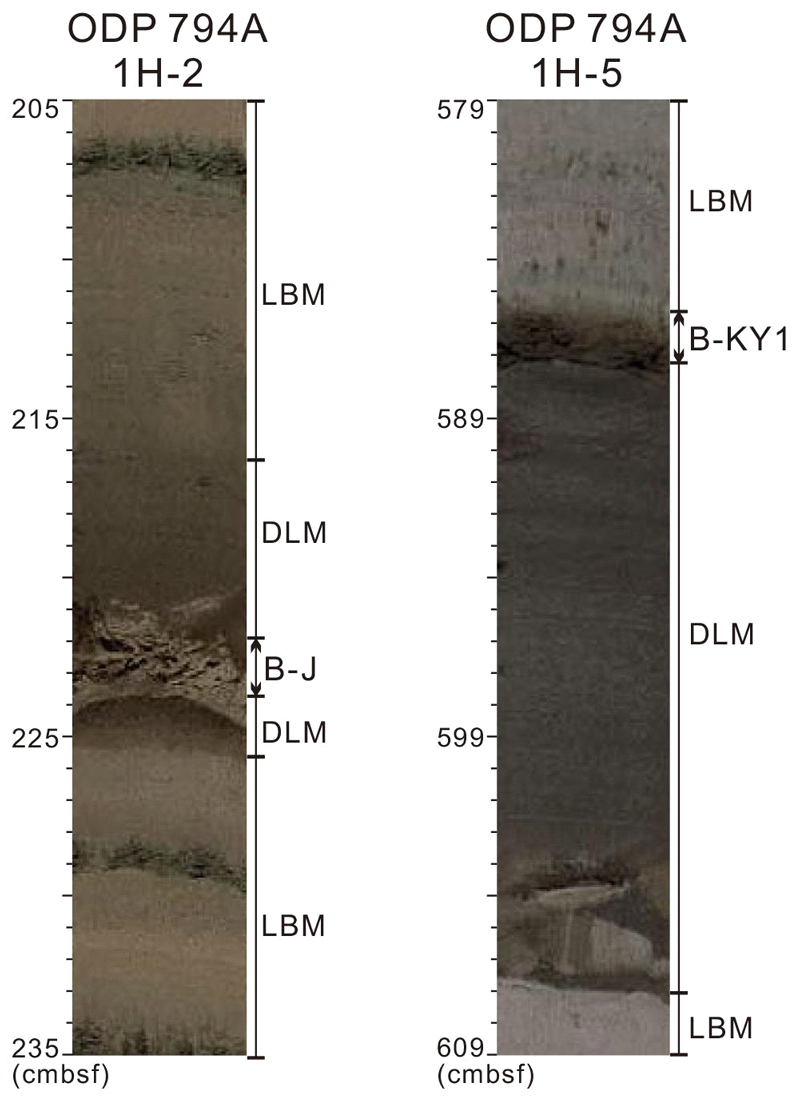
Photographs showing Baekdusan-Japan Basin (B-J) and Baekdusan-KitaYamato1 (B-KY1) tephras in ODP 794A marine core from the East Sea (adapted from Chun and Cheong, 2020). The B-J tephra is characterized by its milky white appearance within the dark-colored laminated mud (DLM). The B-KY1 tephra is identified by its reddish brown hue, situated in the lowermost section of the light-colored bioturbated mud (LBM). The position of ODP 794A marine core is depicted in Figure 1.
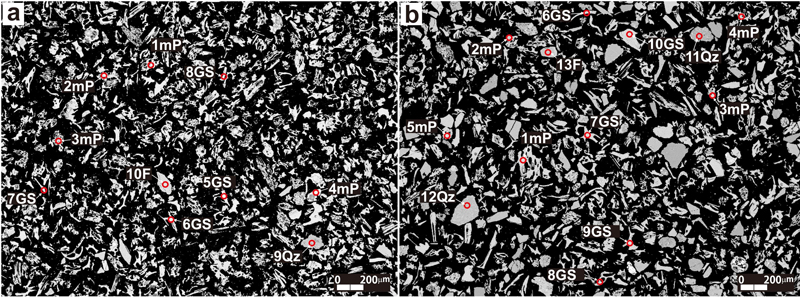
Backscattered electron image (BSEI) of B-J (a) and B-KY1 (b) tephras in ODP 794A marine core from the East Sea. F: feldspar, GS: glass shard, mP: micropumice, Qz: quartz.
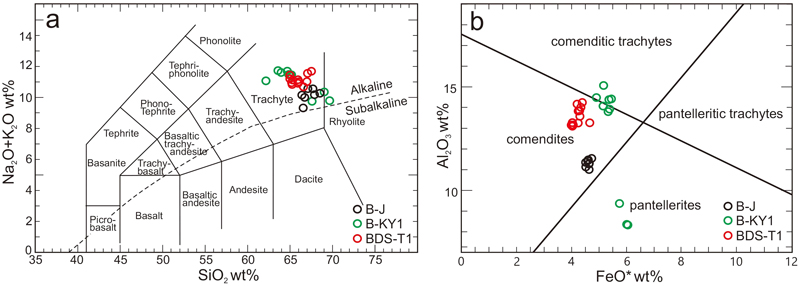
Diagrams depicting total alkali versus silica (a; classification diagram from Le Bas et al., 1986) and Al2O3 versus iron (b; classification diagram adapted from MacDonald, 1974) for B-J, B-KY1, and BDS-T1 tephras.
백두산 화산의 육상 BDS-T1 테프라는 백두산 북측 사면 정상부를 덮고 있는 Baitoushan III 조면암/코멘다이트 용암류의 직하부에서 채취되었다(그림 5; Wei et al., 2013). 이 육상 BDS-T1 테프라는 적갈색을 띄며 상부를 덮는 용암류와의 경계가 뚜렷이 구별되는데, 식생의 발달에 의해서 BDS-T1 테프라의 총 두께는 확인되지 않았지만 최소 1 m에 달한다(그림 5b). 육상 테프라층은 부석과 입자 집합체(aggregates)로 구성되어 있다(그림 6). 입자 집합체는 입자 크기 1 mm 이하의 미세부석, 부석, 반정 들이 방향성 없이 배열되어 있다(그림 6a; 표 2). BDS-T1A 시료에서는 장석 반정(그림 6a; 표 2; 8F)의 가장자리에 밝은 후방산란 특성은 갖는 유리질 성분(그림 6a; 표 2; 1P)이 나타나는데, 이것은 반정 광물이 뜯겨져 나오면서 남겨진 유리질 부분이다(표 2). 이러한 반정 가장자리에 밝은 후방산란 특성은 동해 ODP 794A 해저코어의 B-KY1 테프라에서도 관찰되었다(그림 3a; 13F). BDS-T1A 입자 집합체 미세부석과 부석의 Al2O3 (13.59~14.23 wt.%), CaO(0.11~0.15 wt.%), FeO* (4.21~4.39 wt.%) 함량은 거의 일정하며, BDS-T1B 부석의 Al2O3(13.07~13.26 wt.%), CaO(0.09~0.13 wt.%), FeO*(3.91~4.65 wt.%) 함량과 거의 유사하다(그림 6; 표 2). BDS-T1 테프라의 TAS 도표에서는 조면암으로 분류되고(그림 4a), Al2O3 versus FeO* 도표에서는 코멘다이트로 분석되었는데(그림 4b), B-J 테프라의 주원소 조성보다 B-KY1 테프라의 주원소 조성과 일부 겹친다(그림 4). BDS-T1B 시료의 반정은 상대적으로 밝은 후방산란 특성을 갖는 철-티탄 산화광물(Fe-Ti oxide mineral, 그림 6b; 9FTO)과 휘석(그림 6b; 10Py)으로 구성되어 있으며, 철-티탄 산화광물의 FeO* 함량은 59.86 wt.%이고 TiO2 함량은 19.26 wt.%이다(표 2).
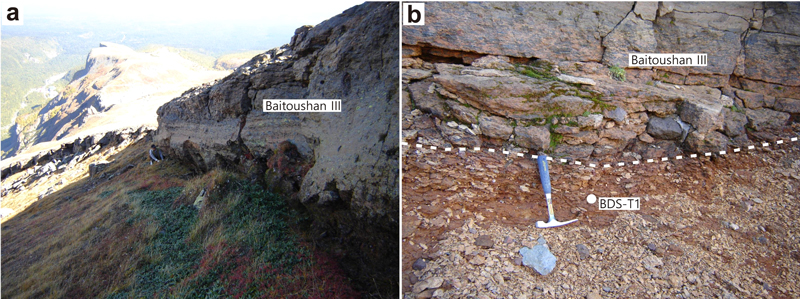
Photographs showing Baitoushan III trachyte/comendite lava (a) and the underlying Baekdusan-T1 (BDS-T1) tephra deposits (b) on the northern slope of Baekdusan volcano.
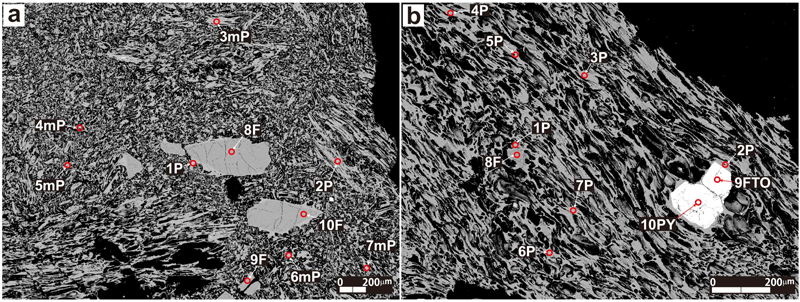
Backscattered electron image (BSEI) of BDS-T1 tephra on the northern slope of Baekdusan volcano. (a) aggregates comprising phenocrysts, micropumice, and pumice, (b) single pumice grain, F: feldspar, FTO: Fe-Ti oxide mineral, mP: micropumice, P: pumice, Py: pyroxene.
백두산 화산의 Baitoushan III 조면암/코멘다이트 용암류는 ‘원뿔형 화산체 형성 시기(cone construction)’의 최후기에 해당되며, Baitoushan III 형성 시기는 20,000년~220,000년 전으로 보고되었다(Wei et al., 2013). 백두산 화산 육상에서 채취된 BDS-T1 테프라는 층서적으로 Baitoushan III 조면암/코멘다이트 용암류의 직하부에 위치한다. 백두산 화산에서 펜텔러라이트 용암류는 100,000년~400,000년 시기에만 형성된 것으로 보고되었는데(Liu et al., 2015), 이 시기는 Baitoushan III 조면암/코멘다이트 용암류 형성 시기와 일부 겹쳐진다. 동해 ODP 794A 해저코어에서 보고된 중기 플라이스토세 시기에 원거리 이동하여 퇴적된 펜텔러라이트 성분을 포함된 B-KY1 테프라는 백두산 화산의 펜텔러라이트 용암류 분출 시기에 발생된 플리니식 분화 가능성이 높다. 그리고 백두산 화산의 ‘천년분화(millennium eruption)’ 퇴적층에 포함된 저어콘의 형성 시기가 110,000년~130,000년 전으로 분석되었는데(Pan et al., 2017; Cheong et al., 2019), 이 증거도 B-KY1 테프라(약 135,000년 전)가 백두산 화산의 플리니식 분화에 의해서 이동 퇴적된 것을 지시하는 것이다.
4. 결 론
동해 ODP 794A 해저코어에서는 적갈색의 B-KY1 테프라(약 135,000년 전)가 나타나는데, 미세부석, 유리질 샤드와 장석 및 석영 반정으로 구성되어 있다. B-KY1 테프라는 Al2O3 versus FeO* 도표에서 코멘다이트질 조면암과 코멘다이트, 펜텔러라이트의 다중모드로 나타나며, 입자의 형태적 특징에 따라서 주원소 성분이 구별되지 않는다. 백두산 화산의 육상에서는 Baitoushan III 조면암/코멘다이트 용암류(20,000년~220,000년 전) 직하부에서 적갈색 BDS-T1 테프라가 확인되었다. BDS-T1 테프라는 TAS 도표에서는 B-J 테프라와는 뚜렷이 구별되지만, B-KY1 테프라와는 일부 겹치는데, Al2O3 versus FeO* 도표에서는 코멘다이트 성분만 나타난다. 백두산 화산에서는 펜텔러라이트 용암류가 100,000년~400,000년 전에만 형성된 것으로 보고되었는데, 이 시기에 백두산 화산의 플리니식 분화가 발생하여 동해의 해저코어에 펜텔러라이트 성분이 유일하게 포함된 B-KY1 테프라가 퇴적되었을 가능성이 있다. 이와 같이 백두산 화산의 육상 테프라에 대한 연구는 플리니식 분화로 원거리 이동 퇴적된 해저코어에 협재된 테프라들의 기원 화산체와 분화 시기 해석에 도움을 줄 것이다.
Acknowledgments
본 연구는 한국지질자원연구원에서 수행 중인 “한반도 활화산 특성평가 및 화산 감시 기반기술 개발(23-3122)” 사업에서 지원되었다. 백두산 화산에서 육상 BDS-T1 테프라 시료 채취는 2005년 강원대학교에서 수행되었던 “ODP 794A 시추공의 시간층서연구와 백두산 화산활동의 중요성” 사업에서 지원된 것이다. 경상국립대학교 첨단소재분석지원센터의 전자현미분석에 도움을 준 김진주씨에게 감사드린다. 이 논문의 심사과정에서 좋은 의견을 제시해 주신 편집위원과 심사위원들께 감사드린다.
References
-
Cheong, A.C.-S., Jeong, Y.-J., Jo, H.J. and Sohn, Y.K., 2019, Recurrent Quaternary magma generation at Baekdusan (Changbaishan) volcano: New zircon U-Th ages and Hf isotopic constraints from Millennium Eruption. Gondwana Research, 68, 13-21.
[https://doi.org/10.1016/j.gr.2018.11.006]

-
Chun, J.-H., 2022, Reconstruction of the history of Plinian eruptions using the marine tephrostratigraphy of volcanoes around the East Sea, Korea. Journal of the Geological Society of Korea, 58, 527-540 (in Korean with English abstract).
[https://doi.org/10.14770/jgsk.2022.58.4.527]

-
Chun, J.-H. and Cheong, D., 2020, Origin of compositional diversity of marine tephra during the Late Middle Pleistocene B-KY1 Baekdusan volcanic eruption. Applied Sciences, 10, 4469.
[https://doi.org/10.3390/app10134469]

- Chun, J.-H., Cheong, D., Han, S.-J., Huh, S. and Yoo, H.-S., 2006a, Tephrostratigraphy and paleoenvironments of marine core in the Kita-Yamato Trough, East Sea/Japan Sea. Economic and Environmental Geology, 39, 83-93 (in Korean with English abstract).
- Chun, J.-H., Cheong, D., Lee, Y.-J., Kwon, Y.-I. and Kim, B.-C., 2006b, Stratigraphic implications as a time marker of the B-J tephra erupted from Baegdusan volcano discovered in the marine cores of the East Sea/Japan Sea during the late Pleistocene. Journal of the Geological Society of Korea, 42, 31-42 (in Korean with English abstract).
-
Horn, S. and Schminke, H.-U., 2000, Volatile emission during the eruption Baitoushan Volcano (China/North Korea) ca. 969 AD. Bulletin of Volcanology, 61, 537-555.
[https://doi.org/10.1007/s004450050004]

- Jin, B.L. and Zhang, X.Y., 1994, Researching Volcanic Geology in Mount Changbai. National Education Press, Changchun, 223 p (in Chinese).
-
Le Bas, B.J., Le Maitre, R.W., Streckeisen, A. and Zanettin, B., 1986, A chemical classification of volcanic rocks based on the total alkali-silica diagram. Journal of Petrology, 27, 745-750.
[https://doi.org/10.1093/petrology/27.3.745]

-
Liu, J.-Q., Chen, S.-S., Guo, Z.-F., Guo, W.-F., He, H.-Y., You, H.-T., Kim, H.-M., Sung, G.-H. and Kim, H., 2015, Geological background and geodynamic mechanism of Mt. Changbai volcanoes on the China-Korea border. Lithos, 236-237, 46-73.
[https://doi.org/10.1016/j.lithos.2015.08.011]

-
Machida, H. and Arai, F., 1983, Extensive ash falls in and around the Sea of Japan from large Late Quaternary eruptions. Journal of Volcanology and Geothermal Research, 18, 151-164.
[https://doi.org/10.1016/0377-0273(83)90007-0]

-
MacDonald, R., 1974, Nomenclature and petrochemistry of the peralkaline oversaturated extrusive rocks. Bulletin of Volcanology, 38, 498-516.
[https://doi.org/10.1007/BF02596896]

-
McLean, D., Albert, P.G., Nakagawa, T., Staff, R.A., Suzuki, T., Suigetsu 2006 Project Members and Smith, V.C., 2016, Identification of the Changbaishan ‘Millennium’ (B-Tm) eruption deposits in the Lake Suigetsu (SG06) sedimentary archive, Japan: Synchronisation of hemispheric-wide palaeoclimate archives. Quaternary Science Reviews, 150, 301-307.
[https://doi.org/10.1016/j.quascirev.2016.08.022]

-
Pan, B., de Silva, S.L., Xu, J., Chen, Z., Miggins, D.P. and Wie, H., 2017, The VEI-7 Millennium eruptions, Changbaishan-Tianchi volcano, China/DPRK: New field, petrological, and chemical constraints on stratigraphy, volcanology, and magma dynamics. Journal of Volcanology and Geothermal Research, 343, 45-59.
[https://doi.org/10.1016/j.jvolgeores.2017.05.029]

-
Shirai, M., Tada, R. and Fujioka, K., 1997, Identification and chronostratigraphy of Middle to Upper Quaternary marker tephras occurring in the Anden coast based on comparison with ODP cores in the Sea of Japan. The Quaternary Research, 36, 183-196 (in Japanese with English abstract).
[https://doi.org/10.4116/jaqua.36.183]

-
Wei, H., Liu, G. and Gill, J., 2013, Review of eruptive activity at Tianchi volcano, Changbaishan, northeast China: implications for possible future eruptions. Bulletin of Volcanology, 75, 706.
[https://doi.org/10.1007/s00445-013-0706-5]

-
Wei, H., Sparks, R.S.J., Liu, R., Fan, Q., Wang, Y., Hong, H., Zhang, H., Chen, H., Jiang, C., Dong, J., Zheng, Y. and Pan, Y., 2003, Three active volcanoes in China and their hazards. Journal of Asian Earth Sciences, 21, 515-526.
[https://doi.org/10.1016/S1367-9120(02)00081-0]

-
Wei, H., Wang, Y., Jin, J.Y., Gao, L., Yun, S.-H. and Jin, B.L., 2007, Timescale and evolution of the intracontinental Tianchi volcanic shield and ignimbrite-forming eruption, Changbaishan, Northeast China. Lithos, 96, 315-324.
[https://doi.org/10.1016/j.lithos.2006.10.004]

